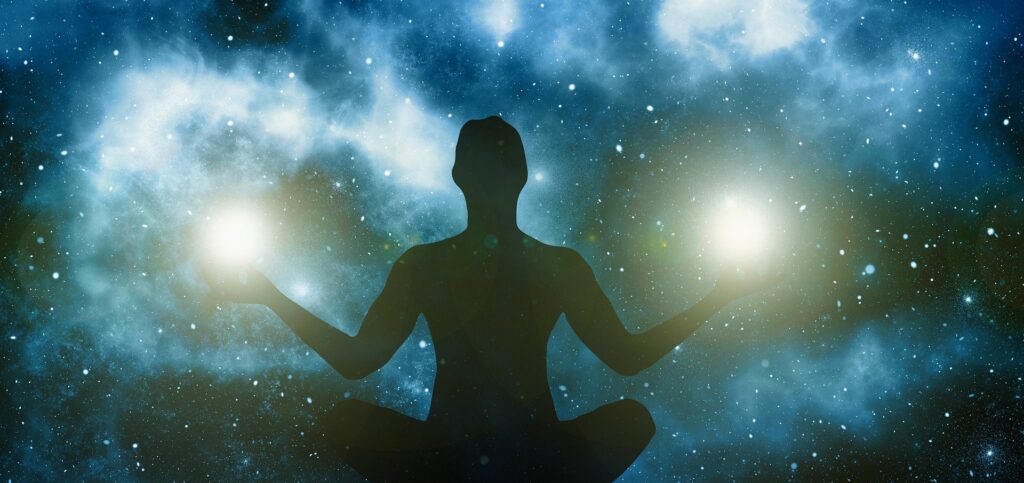
This article takes a closer look at the terms brahman and atman, which are often used in yoga? How can these profound concepts be understood?
The term brahman
In Hindu philosophy, Brahman (Sanskrit, n. ब्रह्मन् brahman) refers to the spiritual world of the archetypes of the entire creation of the world, from which all ideas, thoughts and forms originate.1 However, this spiritual world is not a monotheistic divine absolute. Rather, this philosophy describes a pluralism that expresses itself in various deities and a multitude of images and virtues.2 However, this diverse spiritual world is not a dimension that is distant and unknowable to humans. As a rule, however, they are not sufficiently aware of it and therefore usually live in a so-called maya, an ignorance and illusion. According to the world view of advaita-vedanta, this maya shrouds the only real brahman like a veil of mist, so that people only perceive the earthly world of phenomena and mistakenly believe it to be permanent.3
In Western philosophy, Plato calls this superordinate dimension, on which all earthly phenomena are based, the world of ideas. According to this, the world of ideas represents the true reality, while all sensually perceptible objects are merely an imprint of it.4 Rudolf Steiner coined the term ‘spirit land’ for this world of ideas. It contains the spiritual archetypes of all things and beings that exist in the world and from which human thoughts also spring. Just as the shadow on a wall represents the image of an object, human thought represents an image of an archetype of this thought from the spirit land. 5
This superordinate, apersonal reality, which is expressed in the various terms brahman, world of ideas, spiritual world or spirit land, cannot be directly grasped or even seen by the human being with the senses. However, by training the powers of consciousness of thinking, feeling and willing, it can be experienced in a differentiated way and finally expressed personally by the individual. This individual expression is called atman when realization reaches the highest level of cognition.
The term atman
Atman (Sanskrit, n., आत्मन्,) can be translated as the breath of life. It describes an inherent seed in every human being that wants to unfold to a higher level in the course of life. It is generally understood to mean the realized self, which can also be referred to as the “individual core of being”.6 In the ancient writings of Indian philosophy, the Upanishads, however, the individually realized soul is not viewed in isolation, but is understood in close connection with a greater whole, a world soul.7 While brahman describes the apersonal world of the spirit, atman refers to the realized personal individual.
The connection between brahman and atman
In the teachings of the Indian philosopher Shankara, the two terms are equated, which means that atman is of the same quality as brahman.8 This describes how the individually realized soul atman becomes an expression of the spiritual world of ideas and thoughts brahman.9 In Indian philosophy, this path is divided into the three stages of manas, buddhi and atman. Following on from this, Heinz Grill developed the “New Yoga Will”, a contemporary spiritual training path that focuses on the idea of development and describes in practical terms how every person can develop a universal idea into an ideal worth striving for and ultimately express this through their entire personality.
The three stages: manas, buddhi, atman
Manas generally describes thinking characterized by logic. In its simplest form, it refers to all reflective and receptive thought processes. This can ultimately be extended when consciously formed ideas are formed and thought through in a logical sequence. In a more elevated sense, manas describes the human ability to independently develop a universal, superordinate idea into living conceptual images. However, this process is not an intellectual, categorizing one, but describes a sensitive, moving and creative process in consciousness. 10
Buddhi forms the second link and is related to the emotional world. However, this does not refer to the usual emotions that arise automatically from the unconscious, but to conscious and sensitive sensations that are created from the imaginative thinking activity manas. As an idea is developed into concrete concepts over a longer period of time, subtle sensations of truth arise that permeate the person and increasingly connect them with this idea. As a result, the realization of this ideal becomes a deep concern within the person.
Atman touches the deepest soul power of the will and comes into development when an idea expresses itself through the power of thinking manas, combined with deep feelings of truth buddhi, into the entire personality structure and thus the will atman. However, this realized and developed willpower does not stand for itself in isolation, but ideally in a coordinated connection to the higher laws of the spiritual world brahman and thus also to fellow human beings. The individual person then represents a universal wisdom through his whole person and radiates this through his actions and words. The realization of a higher ideal for a whole gives a natural authenticity, has a strengthening effect on fellow human beings and the environment and ultimately edifies the entire cosmos. 11
Shankara’s statement is: “atman is equal to brahman” and, as explained, it means that the highest level of realization that a person attains corresponds to the primordial spiritual world brahman.
by Julija
Sources:
1 https://heinz-grill.de/geistige-heimat-gegen-lugen/
2 Heinz Grill: The 7 sevens of life and the 7 chakras, Synergie Verlag, Roßdorf, 2019, p. 37
3 Helmtrud Wieland: Das Spektrum des Yoga, 1992, Verlag Hinder und Dehlmann, Gladenbach, p. 323
4 https://de.wikipedia.org/wiki/Ideenlehre
5 https://anthrowiki.at/GA_9#III._Das_Geisterland
6 Helmtrud Wieland: Das Spektrum des Yoga, 1992, Verlag Hinder und Dehlmann, Gladenbach, p. 134
7 Heinz Grill: The 7 sevens of life and the 7 chakras, 2019, Synergie Verlag, Roßdorf, p. 203
8 Helmtrud Wieland: Das Spektrum des Yoga, 1992, Verlag Hinder und Dehlmann, Gladenbach, p. 243
9 https://de.wikipedia.org/wiki/Shankara
10 Heinz Grill: The 7 sevens of life and the 7 chakras, Synergie Verlag, Roßdorf, 2019, p. 191
11 https://heinz-grill.de/geistige-heimat-gegen-lugen/
